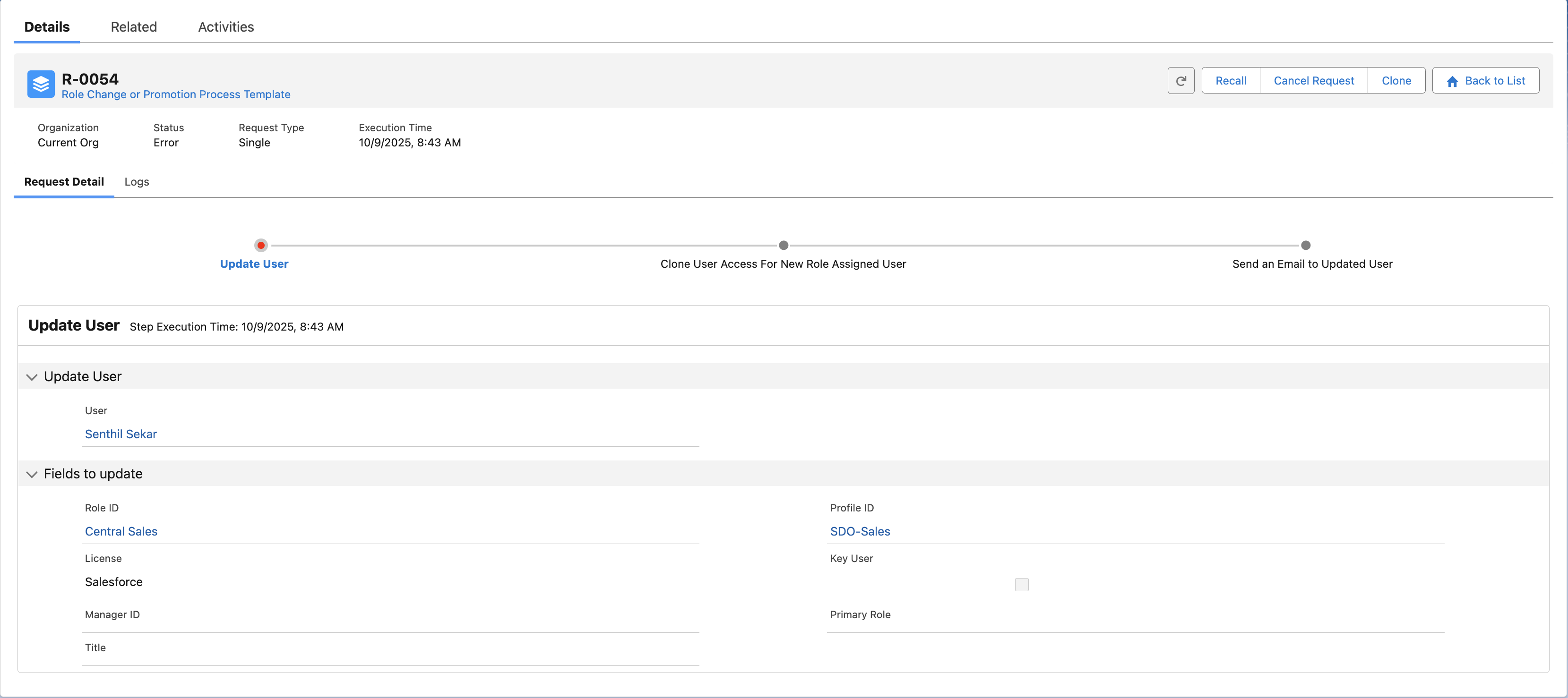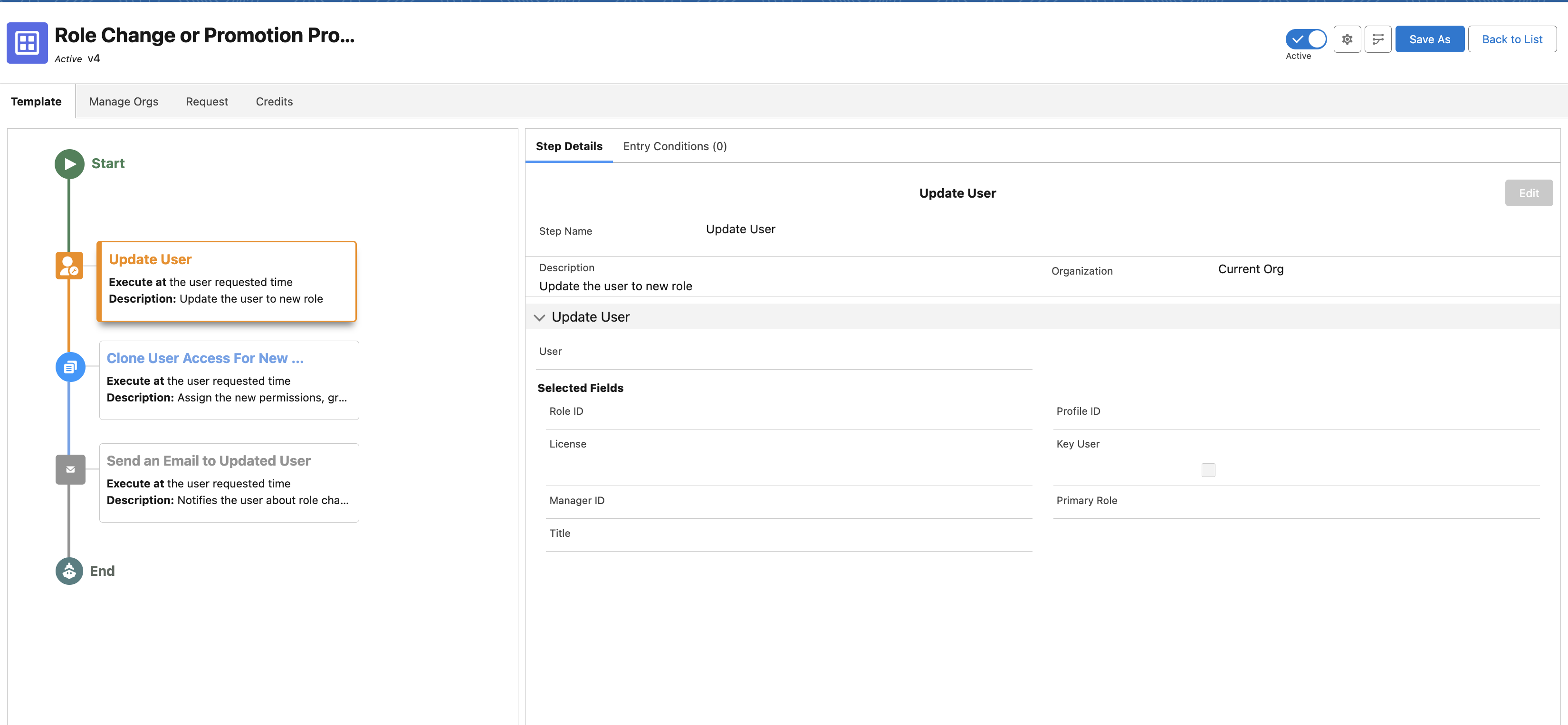Fixing Role Change Access in Salesforce
.svg)
Table of Contents
Meet Sarah: A Salesforce Admin’s Daily Struggle
Sarah is a Salesforce Admin at a growing company. Last week, one of her sales reps was promoted to Sales Manager. Sounds great, right? For Sarah, it meant a long checklist of changes:
- Update the user’s role and profile.
- Assign new permission sets for Sales Manager tasks.
- Revoke old access that’s no longer needed.
- Add the user to new queues and public groups.
- Adjust package and permission set licenses.
- Notify managers that access has been updated.
Each step had to be done manually, cross-checked across different screens, and double-verified so nothing slipped through. One oversight could leave the user with too much access (a compliance issue) or too little access (stalling productivity).
By the end of the day, Sarah was firefighting permissions instead of focusing on more strategic Salesforce work.
The Solution: Automating Role Changes with User 360
In User 360, everything begins with a request — because it keeps the process structured, repeatable, and auditable. For Sarah, this means role changes no longer involve scattered updates across Salesforce. Instead, she follows a clear path:
- Select a Template
- Sarah opens the Role Change Template that has the right actions already defined.
- She can either use Clone User Access to mirror everything from an existing Sales Manager, or pick individual actions like assign permission sets, add to public groups, remove old licenses, send an email.
- Choose Single or Multiple Users
- If only one sales rep is promoted, Sarah creates a single-user request.
- If multiple reps are moving into new roles together, she switches to a multi-user request, uploads their details in bulk, and applies the same template across all of them.
- Set the Timing
- Sarah can run the request immediately.
- Or she can schedule it for the promotion date, so the new access goes live exactly when needed.
- Submit and Track
- Once submitted, Sarah can see a progress bar showing each step in the process.
- The logs capture what completed, what skipped, and any errors — giving her a full audit trail.


Why Repeating is Easy
Once Sarah has the template in place, she never has to rebuild it.
- If another promotion happens tomorrow, she just creates a new request from the same template.
- If multiple users are promoted together, she can reuse the template in a multi-user request, applying changes in bulk.
- For any new role change scenario, she simply repeats the request process, and User 360 takes care of the automation.
Behind the Scenes: Why It Feels Effortless
The reason it feels so simple for Sarah is the automation framework built into User 360:
- Process Templates: Define all role-change steps once — update details, assign new permissions, revoke old ones, add to groups, even send notifications. Every promotion runs the same way, consistently.
- Real-Time Enablement: Set triggers so when a user’s role or profile changes, the right template fires automatically. No waiting for admins to notice — the updates happen in real time.
- Step-Specific Actions: Templates can reflect real business logic:
- If Role = Sales Manager → assign Sales Manager permission set.
- If Location = North America → add to Regional Queue.
- If Package = CPQ no longer needed → remove license.
- Editable Fields: Keep templates flexible. For example, Sarah can leave the “Group” field editable so a requestor can pick the correct public group at the time of submission.

This combination means admins aren’t just automating one promotion — they’re building a repeatable framework for Salesforce role change automation.
Sarah’s New Reality
Instead of scrambling through permission sets and spreadsheets, Sarah now sets up requests once and trusts User 360 to handle role changes correctly every time.
- Access stays aligned to roles.
- Compliance risks are minimized.
- Her Salesforce users stay productive from day one in their new role.
And Sarah finally gets her evenings back.
Wrapping Up
Role changes in Salesforce no longer need to break access or drain admin time. With User 360, Salesforce Admins can define the right actions once, trigger them automatically, and track every update with confidence.
👉 Try User 360 and see how Salesforce role change automation can simplify user management in your org.
Ready to Transform with AI?
Related Blogs

Why OpenAI is Transforming Equipment Repair

Why OpenAI is Transforming Equipment Repair

Why OpenAI is Transforming Equipment Repair




